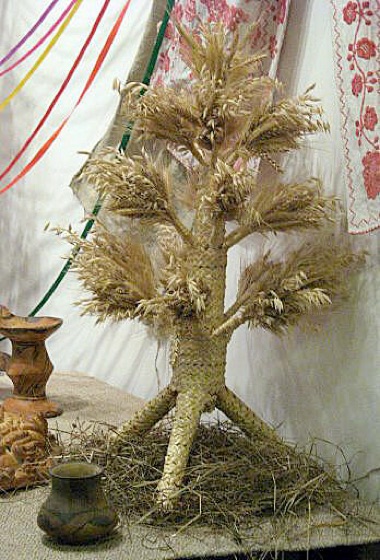Дідух
Didukh
Дідух
Didukh

One of the hallmarks of the Sviat Vechir celebration is the head of the household bringing the didukh, a sheaf made of stalks of grains, into the house. The didukh was made of wheat, rye and/or barley stalks, either the first or last grain harvested, depending on local tradition.
The didukh was given a place of honor in the pokutia, the corner of the house where the icons were hung. It would be left there until after Yordan, and then burned ritually.
What is the Didukh?
translated from Kylymnyk, Volume 1 (Winter), pp. 23-24
The Sheaf-Didukh (“Rai/Paradise”) is the place where the spirits of the ancestors dwell, the guardians or “protectors” of the home. Ukrainians in ancient times believed that these spirits (souls) of the dead were holy spirits, that they were benefactors of their lineage/family. In the summer they lived in the fields and among the livestock; they helped the crops, protecting them from storms, from hail and drought. They helped the offspring of the livestock, protecting it from all evil, and providing good pasturage.... Together, the spirits–Lada are intermediaries between the god-sun and the people......
The god-sun was a giver of riches and life on earth. These spirits (souls) came from heaven and settled in the bodies of people, and after their deaths they again returned to the land of the sun, to the land of the spirits. When the fields were reaped, the spirits–Lada settled into the last honored “sheaf-Didukh” or “Rai/Paradise,” and migrated to the landowner’s barn for the winter. The rest of the spirits settled into the forests, ravines and valleys, until the god-sun called them once again in the spring and sent them out again on the day of New Year*, back into the fields.
This is why there is such regard for the “Didukh,” and why it has this name (grandfather)––in it live the spirits of the grandfathers-ancestors... Since all of the souls of the dead were considered to be holy, they had to live in paradise (“Rai”). That is why the didukh is also called the “Snip (sheaf)-Rai.”
The “Didukh-Rai,” besides being the dwelling place of the ancestral spirits and of the god of the harvest/crops, symbolized also the coming year’s harvest, well-being, prosperity, and people’s fate.
This is why there is such respect for the Didukh, this is why it is carried into the house with such sanctity, just as it was originally brought from the fields with such honor. This is why it is placed in the most honored spot in the house, and why people place before it before it the offering of “divine” food––kutia and the “divine drink” –– (uz)var...
______
* New Year’s Day was celebrated in the spring in earlier times.
The winter home of our ancestors
